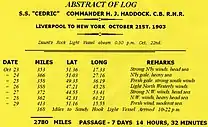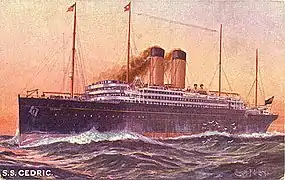RMS Cedric
RMS Cedric was an ocean liner owned by the White Star Line. She was the second of a quartet of ships over 20,000 tons, dubbed The Big Four, and was the largest vessel in the world at the time of her launch.[2] After her maiden voyage in 1903, she was in service until 1932.
 RMS Cedric at sea during 1910's | |
| History | |
|---|---|
| Name: | RMS Cedric |
| Operator: | White Star Line |
| Port of registry: | Liverpool |
| Route: | Liverpool to New York |
| Builder: | Harland and Wolff, Belfast |
| Yard number: | 337 |
| Launched: | 21 August 1902 |
| Completed: | 31 January 1903 |
| Maiden voyage: | 11 February 1903 |
| Out of service: | 1931 |
| Homeport: | Liverpool |
| Fate: | Sold to Thos. W. Ward and scrapped at Inverkeithing in 1932 |
| General characteristics | |
| Tonnage: | 21,035 GRT[1] |
| Length: | 700 ft (213.4 m) o/a |
| Beam: | 73 ft (22.3 m) |
| Depth: | 44 ft (13.4 m) |
| Decks: | 5 |
| Installed power: | 14,000 ihp (10,000 kW) |
| Propulsion: |
|
| Speed: | 17 kn (20 mph; 31 km/h) |
| Capacity: | 1,223 passengers |
| Crew: | 486 officers and crew |
| Notes: | Ship colours: black hull with gold line, red boot-topping, upper works white, funnels: White Star Buff |
History
Construction
Cedric was laid down in 1902 at the shipyard of Harland and Wolff, Belfast. She was the second of White Star's series known as the "Big Four", the other three being RMS Celtic, Baltic and Adriatic. Celtic was the first ship to exceed Brunel's SS Great Eastern in overall tonnage, which was quite an accomplishment, considering Brunel's giant ship held the size record for almost 40 years. Except for the Adriatic all of these in turn, when built, would be the largest ship in the world for a short time. RMS Cedric was a 21,035-gross register ton ship, 700 ft (210 m) long and 75 ft 3.6 in (22.951 m) abeam, with two funnels, four masts, two propellers and a service speed of 16 kn (18 mph; 30 km/h). There was accommodation for 365 first-, 160 second- and 2352 third-class passengers, and a crew of about 350. She was launched in Belfast on 21 August 1902, in a private ceremony which included several guests, amongst others William Pirrie, the chairman of Harland and Wolff and Bruce Ismay, chairman of White Star Line.[3] RMS Cedric commenced her maiden voyage from Liverpool to New York on 11 February 1903. This was the only route on which she was ever used, although Cedric was also sometimes used for winter cruises to the Mediterranean.
Trans-Atlantic service


For the next 11 years the ship plied the Atlantic crossing without any major incident. When the RMS Titanic sank in April 1912, Cedric was in New York City and the ship's departure was delayed until the RMS Carpathia arrived with survivors, including crew members not required for the court of inquiry, who wished to travel back to Liverpool. However, Cedric had to sail without any of Titanic's survivors or crew due to their mandated appearances for testimony at the U.S. inquiry. Her last civilian voyage on the Liverpool-New York service started on 21 October 1914, after which she was requisitioned for war service, and she was then converted to an armed merchant cruiser. Cedric was decommissioned in 1916, and then she was converted into a troopship for operation initially to Egypt and then to the U.S. In April 1917, her operation came under the auspices of the Liner Requisition Scheme. On 1 July 1917, Cedric collided with and sank the French schooner Yvonne-Odette with the latter losing 24 of her crew. On 29 January 1918, Cedric collided with and sank the Canadian Pacific ship Montreal off Morecambe Bay. Montreal was taken in tow, but she sank the next day 14 mi (12 nmi; 23 km) from the Mersey Bar lightship. Cedric was returned to her owner in September 1919 and refitted by Harland & Wolff. She was refitted to accommodate 347 first-, 250 second- and 1000 third-class passengers. She resumed Liverpool–New York voyages. On 30 September 1923, Cedric collided with the RMS Scythia of the Cunard Line in Queenstown (Cobh) harbour during dense fog. Neither vessel was seriously damaged. On 23 October 1926, she was again altered to cabin, tourist and third class. Her last Liverpool–New York sailing commenced on 5 September 1931 and she was sold later the same year, for £22,150 to Thos W Ward and scrapped at Inverkeithing in 1932.
Notable passengers
The leader of the Baháʼí Faith, `Abdu'l-Bahá, traveled on the R.M.S. Cedric from Alexandria, Egypt, leaving on 25 March 1912, travelling via Naples, Italy on 28 March[4] and arriving in New York City on 11 April 1912.[5] On 5 December 1912 he again traveled on the Cedric from New York to Liverpool.[6] Shoghi Effendi, as a youth 15 years old, accompanied ‘Abdu’l-Bahá from Egypt, disembarking in Italy.[4]
Titanic survivor Robert Williams Daniel, a banker who frequently travelled to England on business, returned to New York from Liverpool on the R.M.S. Cedric, arriving on 4 December 1912 to learn of the death that day of his friend and fellow Titanic survivor Archibald Gracie IV, whom he was to visit while in New York.[7]
Future garment industry trade union leader Sidney Hillman sailed to the United States (his name was spelled Sydney Hilman on the passenger manifest) as a steerage passenger on the Cedric from Liverpool in August 1907.
References
Notes
- "Cedric (1115354)". Miramar Ship Index. Retrieved 22 September 2019.
-
- Roberts, Chalmers (August 1901). "The Biggest Ship". The World's Work: A History of Our Time. II: 1176–1179. Retrieved 9 July 2009.
- "Launch of the Cedric". The Times (36853). London. 22 August 1902. p. 5.
- Mahmúd-i-Zarqání, Mírzá; Mohi Sobhani (1997). Mahmúd's Diary. George Ronald.
- Lacroix-Hopson, Eliane; `Abdu'l-Bahá (1987). `Abdu'l-Bahá in New York- The City of the Covenant. NewVistaDesign. Archived from the original on 16 December 2013.
- Effendi, Shoghi (1979). God Passes By. US Baháʼí Publishing Trust.
- https://www.encyclopedia-titanica.org/new-entry-19212.html
Bibliography
- Chirnside, Mark (2016). The 'Big Four' of the White Star Fleet: Celtic, Cedric, Baltic & Adriatic. Stroud, Gloucestershire: The History Press. ISBN 9780750965972.
- Osborne, Richard; Spong, Harry & Grover, Tom (2007). Armed Merchant Cruisers 1878–1945. Windsor, UK: World Warship Society. ISBN 978-0-9543310-8-5.
External links
- "New White Star Line Steamship Cedric" (Marine Engineering, April 1903, pp. 165–170, feature article with photographs.)
- RMS Cedric
- Cabin Liners: Celtic / Cedric Interior Tour Archived 3 July 2018 at the Wayback Machine
- Collision with SV Yvonne-Odette
.jpg.webp)
